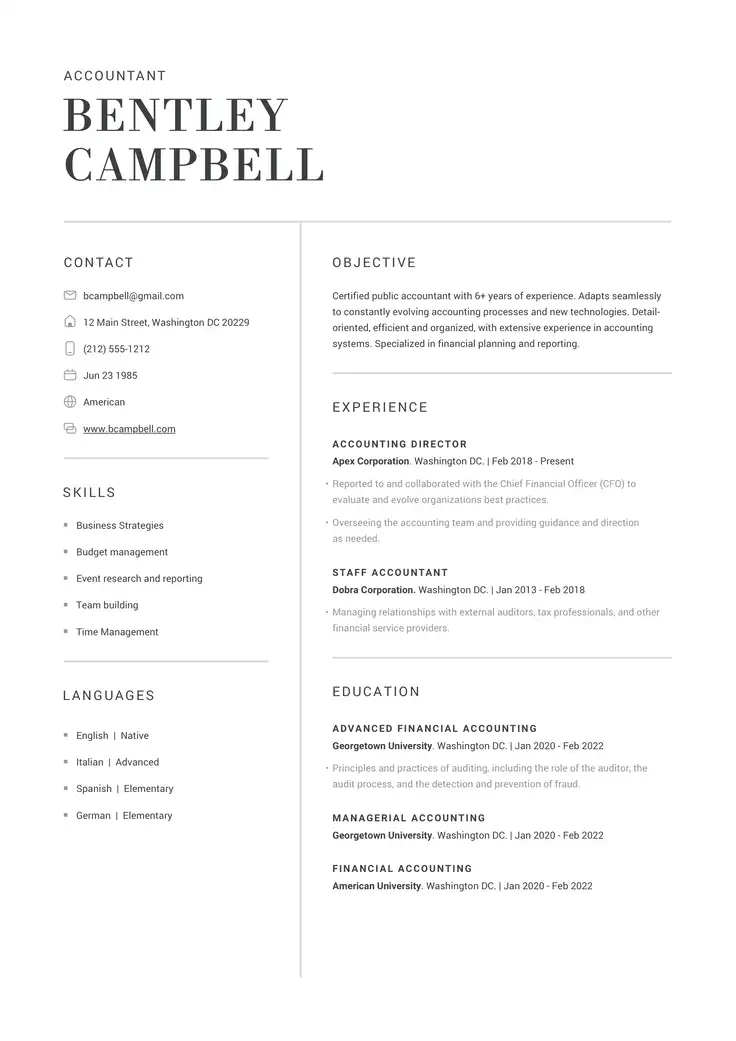First things first, what are accomplishments? On a resume, they are more than just a list of your job duties. They are a testament to your professional achievements and a showcase of your potential to future employers.
Including accomplishments in your resume is crucial because it not only highlights your past successes but also demonstrates how you can add value to a new role.
These achievements to put on a resume set you apart from other candidates by providing tangible evidence of your skills and abilities.
Writing an accomplishment-based resume is simple if you follow this guide and use a resume builder.
Below, we will consider what an achievement or accomplishment is, how to include them on your resume, tips for best utilizing your accomplishments, and examples of the types of accomplishments you might include on your resume.
What Is an Accomplishment or Achievement?
Accomplishments and achievements highlight the impact you’ve had in a given role. They show how you excelled, exceeded expectations, solved problems, or obtained measurable results, such as increased revenue or improved processes. They show how you made a difference at work.
Achievements and accomplishments differ from duties and responsibilities, which are tasks you were assigned to do.
For example, if you work in a grocery store, your duties might include creating displays, training new employees, and ensuring good customer service.
But what if you went above and beyond in these duties? Then, you might accomplish something like cutting fresh produce waste by a percentage by optimizing inventory and displays, improving customer satisfaction surveys by a percentage point, reducing employee turnover by a percentage through training, or winning an Employee of the Month award.
Why should you include accomplishments on your resume?
Listing your accomplishments on your resume is not the same as bragging. It demonstrates the impact and tangible results of your work, proving to employers how you’ve contributed to past roles. This shows future employers that you won’t just grudgingly do your job; you’ll be an enthusiastic member of your team.
Listing achievements also helps differentiate you from other applicants who may have similar job titles but lack quantifiable success. It can help you stand out in a competitive job market.
How to Highlight Accomplishments on Your Resume
You can use this effective step-by-step guide to showcase your key accomplishments, highlighting your unique contributions and successes in your professional journey.
1. Identify Your Accomplishments
Start by reflecting on your career and identifying key achievements. These could include instances where you exceeded targets, implemented successful projects, or received recognition for your work.
Think about the challenges you faced and how you overcame them, as these can also be powerful accomplishments. Later, we’ll examine a list of accomplishments that you might consider including on your resume.
2. Quantify Your Achievements
Whenever possible, quantify your accomplishments with numbers, percentages, or specific outcomes. This approach adds credibility and helps the employer understand the magnitude of your contributions.
For example, “Increased sales by 20% in one year” or “Reduced operational costs by 15% through process optimization” is much more powerful than “worked in sales” or “improved processes.”
3. Tailor Accomplishments to the Job Description
Review the job description of the position you are applying for and align your accomplishments with the requirements of the role. Look for keywords in the job posting–skills, tools, computer software, years of experience, specific degrees or certifications, and the like.
This tailored approach shows that you have the specific skills and experience the employer is seeking.
4. Incorporate Accomplishments in Various Resume Sections
Where you add achievements on your resume will depend on your resume format and what suits you best. Have a look at the following examples:
- Summary or objective: Briefly mention one or two major accomplishments that are highly relevant to the job.
Example
“Dynamic marketing professional with over 10 years of experience, recognized for increasing online engagement by 40% through innovative social media strategies. Seeking to leverage my expertise in digital marketing and team leadership at XYZ Corp.”
- Professional experience: Under each job role, include bullet points of key achievements. Focus on what you accomplished in the role rather than just your responsibilities. Use quantifiable data (numbers or statistics) whenever possible.
- You can use our resume builder’s AI capabilities to make suggestions on phrasing your bullet points.
Example
“Sales Manager, ABC Corporation (2018-2023)
- Spearheaded a team of 15 sales associates, achieving a record-breaking 25% increase in annual sales revenue.
- Implemented a new CRM system, enhancing customer relationship management and boosting repeat business by 30%.”
- Education: If you have notable academic achievements, such as awards or a high GPA, include them in your education section.
Example
“Bachelor of Science in Computer Science, University of Technology (Graduated 2020)
- Graduated Summa Cum Laude with a GPA of 3.9/4.0.
- Awarded the Dean’s List for academic excellence for four consecutive years.”
- Skills section: You can highlight accomplishments that demonstrate specific skills, especially if they are relevant to the job you are applying for.
Example
- “Project Management: Successfully led a cross-functional team in a complex software development project, delivered on time and 15% under budget.
- Bilingual Proficiency: Fluent in English and Spanish, utilized language skills to expand the company’s client base in Latin American markets by 20%.”
If you have a few particularly impressive accomplishments that you want to emphasize, you could create a resume accomplishments section. It can include a bullet-pointed summary of accomplishments or a concise accomplishments statement.
When you add your accomplishments, make sure you avoid the most common resume-writing mistakes.
Have a look at this example of an accomplishments section:
Example
Key Accomplishments:
- Increased Sales Revenue: Spearheaded a new digital marketing campaign that resulted in a 30% increase in sales revenue within the first quarter of implementation.
- Project Management Excellence: Successfully led a cross-functional team in the launch of a new software product, completing the project 2 weeks ahead of schedule and under budget by 10%.
- Award for Customer Service Excellence: Recognized with the 2020 National Customer Service Award for implementing customer feedback systems that improved service delivery and customer satisfaction ratings by 25%.
5. Use Action Verbs and Clear Language
Start your accomplishment statements with strong action verbs and keep the language clear and concise. This makes your resume more dynamic and easy to read.
Leadership & Management
- Managed
- Led
- Supervised
- Coordinated
- Executed
Problem-Solving & Innovation
- Developed
- Innovated
- Designed
- Analyzed
- Streamlined
Communication & Collaboration
- Presented
- Advised
- Trained
- Influenced
- Mentored
Achievement & Results-Oriented
- Achieved
- Delivered
- Increased
- Improved
- Transformed
Efficiency & Process Optimization
- Organized
- Implemented
- Optimized
- Facilitated
- Negotiated
These verbs are effective for starting bullet points that describe your accomplishments, giving your resume a dynamic and proactive feel.
6. Review and Edit
Finally, review your accomplishments to ensure they are clear, concise, and free of jargon. Your achievements must be easily understood by anyone reading your resume.
Your accomplishments are a reflection of your professional journey and the unique value you bring to the table. How you list accomplishments on your resume can significantly enhance your chances of catching a potential employer’s attention.
Additional Tips for Energizing Your Resume with Accomplishments
Enhance the impact of your resume with these additional tips, elevating your professional story to the next level.
Use the CAR method to show your achievements
Similar to the STAR method, the CAR method is an acronym that reminds you to break down your achievements into bite-sized pieces: challenge, action, and result. You can use this formula in your bulleted descriptions.
For example:
A restaurant server might experience the challenge of satisfying customers who are angry over long wait times during peak hours. He or she may take the action of thinking up and suggesting a new table assignment method that better balances the workload among the available servers. The result could be reduced wait times and increased customer satisfaction scores on surveys.
The bullet point would look like this:
- Implemented a new table assignment method to optimize server workload distribution, reducing wait times during peak hours and boosting customer satisfaction scores by X%
Likewise, an experienced restaurant manager might experience the challenge of high employee turnover. He might act by creating a new training program with teambuilding exercises.
The result could be a percentage by which employee turnover rates have been reduced within a year–along with the money saved onboarding and outfitting with uniforms and fewer new hires.
The bullet point would look like this:
- Developed and implemented a new training program with team-building exercises, resulting in a X% reduction in employee turnover within a year and significant cost savings on onboarding and uniforms
The CAR method is an effective thinking tool. Get in your CAR and drive!
Highlight Progression and Growth
Demonstrate how your accomplishments have contributed to your professional growth. For instance, show how an early career achievement led to more significant responsibilities or how continuous learning has enhanced your performance.
Example
“Began as a Junior Developer and progressed to Lead Developer within two years, demonstrating rapid skill acquisition and leadership capabilities.”
Include Non-Quantifiable Achievements
Not all accomplishments are measurable in numbers. Include impactful contributions like improving team morale, leading successful collaborations, or developing new procedures that enhance workflow efficiency.
Example
“Revitalized team morale and enhanced collaboration by initiating regular team-building activities and open feedback sessions, leading to a more cohesive and productive work environment.”
Mention Awards and Recognitions
If you’ve received any awards, recognitions, or commendations, either in your professional or academic life, make sure to include these.
They serve as third-party validation of your skills and achievements.
Example
“Recipient of the 2021 Manager of the Year Award for outstanding leadership and team development.”
Use Testimonials or Endorsements
If you have received positive feedback from supervisors, colleagues, or clients, consider including brief quotes or endorsements that highlight your accomplishments and work ethic.
This adds a level of credibility and personal testimony to your achievements. This is especially effective if you have a bit of blank space to fill at the bottom of your resume.
Example
“John consistently delivers exceptional results. His innovative approach to problem-solving has been a game-changer for our projects.” – Jane Doe, Senior Project Manager
5 Top Mistakes When Writing Accomplishments
The mistakes below can significantly diminish the effectiveness of your resume, so it’s important to address them to present your accomplishments in the best possible light.
- Being vague: Lack of specific details makes your accomplishments less convincing and impactful. It’s crucial to provide clear, concrete examples of what you achieved.
- Failing to quantify achievements: Not using numbers or metrics to demonstrate the scale and impact of your achievements can make them seem less significant. Quantifiable achievements provide a clearer and more compelling picture of your success.
- Listing duties instead of achievements: A common error is to focus on job responsibilities rather than what you accomplished in those roles. Highlight your unique contributions and successes, not just your day-to-day tasks.
- Exaggerating or lying: Overstating your achievements or including false information can seriously undermine your credibility. It’s important to be honest and accurate in your descriptions.
- Poor formatting and structure: If your accomplishments are not presented in a clear format, they may be overlooked or undervalued. Proper formatting ensures that your achievements are easily noticeable and understandable.
Examples of accomplishments to put on a resume: by industry
If you’re still wondering which accomplishments to put on a resume, here are some industry-specific resume accomplishment examples you can use to give you ideas and to help you write an achievements-based resume.
Accounting
“Balanced an annual budget of over $600,000”
“Saved the company 7% over 5 years”
Administrative Assistant
“Responded to over 30 emails a day and resolved customer’s problems”
“Designed email templates, which were used throughout the department”
Customer Service
“Operated a cash register and handled over $10,000 a week”
“Assisted 20 customers a day, making tailored recommendations”
Information Technology
“Saved the company $10,000 by implementing efficiency software”
“Reduced the hours lost through IT problems by 8%”
Nurse
“Provided high-quality care to over 20 patients daily”
“Mentored and led a team of 12 newly-qualified nurses”
Sales
“Top salesperson in the team for 3 years running”
“Boosted sales by over 25% in 2016”
Students (for a student resume)
“Helped to run the History Society which had over 800 members”
“Tutored 6 freshman students and improved each of their grades”
Teacher
“Improved students scores in math by an average of 12%”
“Received three ‘Best Teacher Awards’ in 2012, 2014, and 2015”.
Still unsure about how to list accomplishments on your resume? Don’t fret! Try our AI-assisted resume builder, and you’ll have a powerful, achievements-based, ATS-proof resume in no time.
Related Posts



